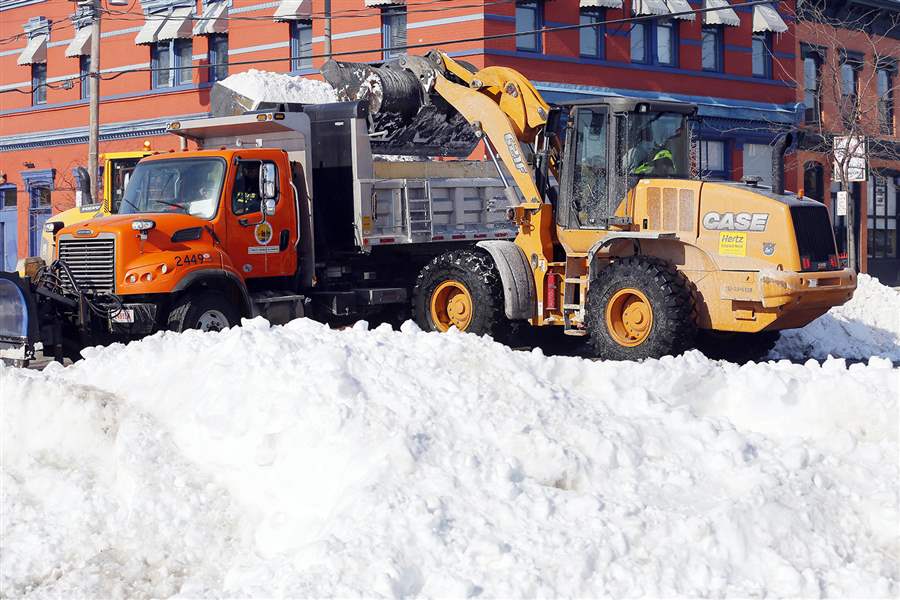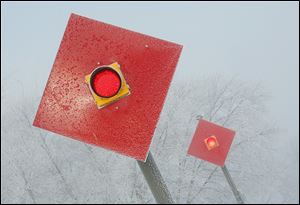
Slow thaw not without issues
Potential for more potholes, flooding lingers across region
2/13/2014
City workers clear snow at South St. Clair and Lafayette streets in downtown Toledo during record-cold temperatures Wednesday.
THE BLADE/AMY E. VOIGT
Buy This Image

City workers clear snow at South St. Clair and Lafayette streets in downtown Toledo during record-cold temperatures Wednesday.
And now, the thaw.
But be forewarned: It, too, may have a price — more potholes and, later on, renewed flooding.
After what was potentially Toledo’s fourth straight subzero morning today — including a daily record low Wednesday morning — weather forecasters agree that a warming trend is on the way for northwest Ohio and southeast Michigan.
The low of -14 degrees at Toledo Express Airport, reached at 6:27 a.m. Wednesday, broke a -10 degree record from Feb. 12, 1917. It marked Toledo’s third record-breaking low temperature this winter, and on three other days this season the record low has been tied.
Jay Berschback, chief meteorologist at WTVG-TV Channel 13, said it was likely at least part of northwest Ohio would fall below zero again early today, although whether that would include Toledo’s official reporting station at the airport was uncertain.
What is clearer, he said, is the warm-up to follow.
It’s expected to be gradual, at least at the beginning, with local temperatures likely not cracking the freezing mark until Monday. Toledo’s last day above freezing was Feb. 1.

Red signals are a stark contrast to the fog and frost that envelop Cullen Park in Point Place.
Between now and then, Toledo is likely to get some more light snow to add onto its historic — but not quite yet record-breaking — season snowfall total of 67.4 inches.
Brian Mitchell, a meteorologist at the National Weather Service office in Cleveland, said that between light snows on Friday and on Saturday night, Toledo is likely to get between 1 and 3 inches. That should be enough to move this season into second place on Toledo’s snowiest-winters list, but not yet threaten the 73.1-inch record set in 1977-78.
Mr. Berschback said he expects less out of the upcoming snows, but probably enough to pass the 68.2-inch snowfall from 1981-82 that holds second place.
With 15.5 inches having fallen just since Feb. 1, this also is the 10th-snowiest February on record for Toledo, following a record-shattering 40.2 inches in January.
Some more minor accumulation could occur during a storm expected to reach the area on Presidents’ Day, but that one is forecast to be mostly a rainmaker.
With $1.6 million spent so far this winter for manpower alone, 2013-14 is already the costliest winter in Toledo’s history, David Welch — the city’s commissioner of streets, bridges, and harbor — said Wednesday.
He’s optimistic that snow during the next few days is “not going to be much.”
The National Weather Service’s seven-day outlook showed highs above freezing continuing Tuesday and Wednesday, with 40 on the horizon for the latter, but temperatures dipping back into the 20s at night.
Those freeze-thaw cycles are likely to create new potholes on Toledo streets, but Mr. Welch said he’s eager to see the warm-up because it also will permit more durable repairs to the damage winter already has wrought on such major streets as Douglas Road, Detroit Avenue, and especially the Anthony Wayne Trail.
The city and the Ohio Department of Transportation have, as hoped, arranged for a local asphalt plant to open up next week so they can use hot-mix asphalt for street repairs, Mr. Welch said.
“Temperatures in the 40s will make the hot mix work,” he said. “If it were still zero out, you might as well be using cold patch.”
In some of the roughest pothole areas, the streets commissioner said, the plan will be to dig out entire sections of bad pavement and replace it with fresh hot asphalt.
“That way, we can get ahead on some of these bad areas,” Mr. Welch said.
Lucas County Engineer Keith Earley said that while county roads are generally in better shape than the worst city streets, “we’ve got some potholes” and repeated freeze-thaw cycles in the forecast likely will bring out more.
Mr. Earley is also wary of ice jams during the upcoming thaw, along with flooding from a combination of rainfall and snow melt.
“A slow warm-up would be better than a fast one,” Mr. Earley said. “Ice in the [Maumee] river is going to be a big problem.”
Minor ice jams occurred on the Maumee, Portage, and other northwest Ohio rivers during a previous thaw in mid-January that was accompanied by rain.
Renewed ice jamming is unlikely “in the short term, through early next week,” Mr. Mitchell said, “but it’s something we’ll be monitoring.”
Mr. Berschback said the greatest threat for flooding is later next week, when much warmer air may flow into the region ahead of a stronger storm he expects to affect the Toledo area at that week’s end.
“With the amount of snow and ice on the ground right now, we are expecting flooding,” the forecaster said. “The ice jamming may be substantial.”
The streets commissioner, meanwhile, also defended Toledo against complaints Wednesday that a crackdown on property owners who don’t shovel their sidewalks is hypocritical in light of the city’s own struggle to clear snow and ice from residential streets and the unshoveled state of sidewalks on some city-owned property.
Many minor streets are coated in several layers, with a lesser rain late last month having turned snowpack into slush that then froze early last week before being buried by fresh midweek snow. Several callers to The Blade on Wednesday said the city should focus on clearing those streets before it starts fining residents for sidewalk conditions.
Mr. Welch said flatly that Toledo can’t afford to have a bare-pavement policy for all streets. The small “sister division” trucks it assigns to the lowest-priority streets during big snows don’t clear all the way to pavement, he said, and spreading salt on every street would double Toledo’s salt use, which already is close to 50,000 tons this year.
“We try to at least make them passable,” but city policy is for everybody to be within two to three blocks of a salted and plowed street, Mr. Welch said.
As for city-maintained sidewalks, the streets commissioner said crews have been out working on sidewalks on bridges, near parks, and on busy school routes, but said he did not know what department was responsible for the walks in front of vacant lots the city owns.
Lisa Ward, a spokesman for Mayor D. Michael Collins, said callers she discussed the matter with became satisfied once she told them that the sidewalk crackdown is focusing on main thoroughfares with bus stops, not minor streets.
One caller to The Blade said her problem is that after she shovels her walk, snowplows throw heavy, slushy snow from the street back onto it, and her health prevents shoveling slush. City inspectors acknowledged that problem on Tuesday, however, and said they intended to be lenient when it was clear property owners had put in appropriate effort to clear their walks.
Contact David Patch at: dpatch@theblade.com or 419-724-6094.